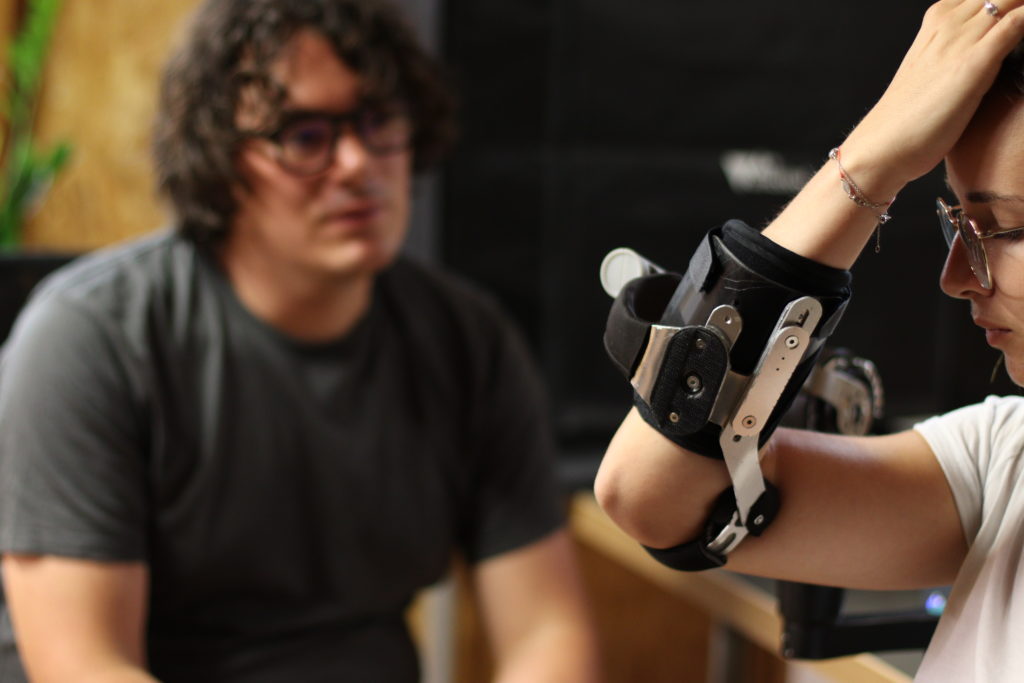Steffi Pan, independent occupational therapist, shares her experience of the equipment with technical aids for the arms. What is the occupational therapist’s and medical team’s role? What are the tips to be equipped in the best way possible?
What role do you play in the equipment of a patient with restricted arm mobility as an occupational therapist?
Our role is to recommend solutions that will be prescribed by their doctor. The referring physician is also able to recommend solutions by himself, but the occupational therapist’s advice is essential in case of special needs. Patients can globally come to occupational therapists to evaluate their capacities, especially the functional aspect and their daily autonomy.
The idea is to identify the daily tasks that are difficult to achieve and which the patient would like to do again or facilitate them. The occupational therapist can therefore suggest testing the technical aids to help the patient with the choice of the device. When installed, the therapist stays with the patient to facilitate the appropriation and use of the device.
The assessment allows to provide preconisations adapted to the patients and their needs. If needed, the medical team can accompany the patient finding the funds to purchase the adapted technical aid.
"The occupational therapist advice is very important in case of special needs"
Steffi PAN, occupational therapist
What do you think about the choice of technical aids for arm mobility available on the market?
There are very few new products that have reached the market. It could be because of the lack of precise and defined needs that were reported to the manufacturers.
On the other hand, it is true that information about the new technologies avialable in the medical field isn’t very well shared with healthcare professionals. Therefore the prescriptors won’t systematically redirect people towards this kind of innovative solutions. The technical devices that are currently available on the market are not well known, so there is a real need to inform the patients and the healthcare professionals about the already existing offer. There’s a real market to develop.
What do you think are the greatest obstacles to the equipment?
Once the solutions are known, there are obstacles to the patient’s equipment : the major one is the price, particularly if the device isn’t reimbursed. In this case, the patient has to balance out between the price of the solution and the benefits it could present to him on a daily basis.
Also, a patient that is starting the process of getting equipped has to be sure of its benefits in the long term. For example, someone for whom the purchased aid would be obsolete after a year, it ain’t worth purchasing it in the first place.
The complexity of use is also a point that hinders patients in the projection of the purchase. The first phase of the equipment is determining, because if the device isn’t fitted well to the patient’s environment, he won’t benefit from its full potential. This is why the patient has to go through a therapeutic education phase in order for him to appropriate the technical aid and verify the benefits on his daily mobility : he really becomes an actor of his reeducation.
It is also necessary to take in account the compatibility with the other technical aids that the patient uses. The solution has to be pertinent and not get in the way of the devices he already has and uses (for example you have to be sure that technical devices command doesn’t stand in the way of the joystick of the electrical wheelchair).
"It is important that the whole team takes in consideration the new device and includes it in its rapport to the patient and his treating process"
Steffi PAN, occupational therapist
Surrounding yourself with your medical team to choose your assistive device is primordial in order to obtain the patient’s full satisfaction.
The occupational therapist is the best reference for this type of equipment and with his experience he is able to suggest the most adapted solutions to your specific and personnel needs. But most of all it is important that the whole team takes in consideration the new device and includes it in its rapport to the patient and his treating process.
The team is also very useful during all the journey before the equipment and for support during the purchase process. They can for example participate in the argumentation to favor the obtainment of the financial funds necessary to the acquisition.
The family’s and helpers opinion can also direct the physical therapist’s knowledge of the patient’s needs. It’s therefore useful for the medical team to ask for their opinion and include them in the equipment process.
Lastly, do not haste, inform yourself and test what is available to make yourself an opinion, this way you will be able to select an efficient solution that you like and that fits you.
- EASTIN : global assistive technology information network
- Technical aids for the upper

